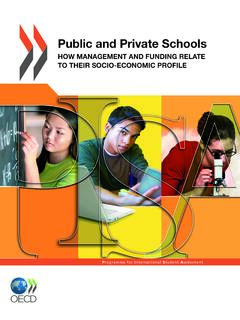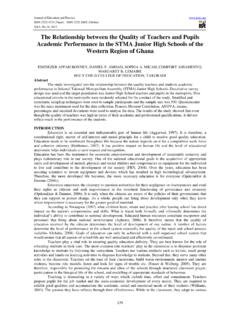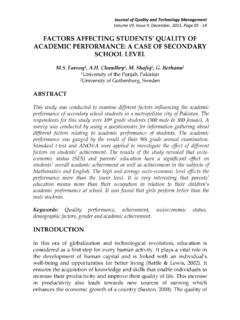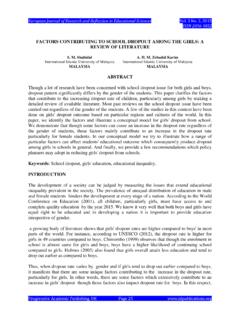Transcription of IRELAND - OECD
1 IRELAND This Data Spotlight note on Early Childhood Education and Care (ECEC) provides a summary of ECEC policy inputs, outputs and outcomes in IRELAND . It uses data available within the OECD Secretariat Education at a Glance, the Programme for International Student Assessment (PISA) and the OECD Family Database to make comparisons between IRELAND s ECEC system and the systems in other OECD countries (see Box 1 for definition and comparability issues). This note complements the 2015 OECD publication, Starting Strong IV: Monitoring quality in Early Childhood Education and Care. Key characteristics of ECEC in IRELAND : Resources that are put in the ECEC system - IRELAND does not report on expenditure of early childhood educational development (ISCED 01), only on pre-primary education (ISCED 02).
2 Annual expenditure per student in pre-primary education (ISCED 02) in IRELAND was USD 6 5321, lower than the OECD average of USD 8 070. - The number of children per staff in pre-primary education (ISCED 02) is comparatively low: there are about 11 children per teacher in IRELAND , which is 3 children fewer per teacher than the OECD average of 14 children per teacher, excluding the non-teaching staff, such as auxiliary staff. Access and participation - IRELAND provides early childhood care and education (ECCE in IRELAND ) free of charge to all children from the age of 3 for 3 hours a day, 5 days of the week, during the school period. - Participation of 0-2 year-olds in formal care is around the OECD average (30% and 33%, respectively).
3 - Participation of 3-5 year-olds in pre-primary education (ISCED 02) is also lower than the OECD average ( for 3-year-olds rates were 46% in IRELAND compared with 71% across the OECD), but there is an early start of primary education. - More than 90% of 4-year-olds are enrolled in pre-primary or primary education. - There are high enrolment rates of pre-primary pupils in private institutions (98% compared with 32% across the OECD). Monitoring quality - In IRELAND there is a national curriculum framework in place for the entire ECEC age group. - Monitoring early childhood education and care settings for service and staff quality is common practice. Despite numerous initiatives to monitor quality , some challenges remain.
4 These include making wider use of children s views on monitoring practices and evaluations; having a common internal monitoring procedure; and, developing a framework for monitoring children s development (see IRELAND 's country note on Monitoring quality in ECEC). Student performance at age 15 by participation in pre-primary education - The percentage of 15-year-olds in IRELAND who reported not attending pre-primary education in PISA 2012 was significantly above average ( compared with across the OECD). Notably, children from lower socio - economic backgrounds and in socio -economically disadvantaged schools were less likely to have participated in pre-primary education. In IRELAND , the relationship between attending pre-primary education and mathematics performance of 15-year-olds is smaller than the OECD average, and is not statistically significant after controlling for students socio - economic background.
5 IRELAND 2 OECD 2017 Introduction Participation in ECEC can have a positive effect on children s early learning and development, as well as on subsequent outcomes, such as academic success, labour market performance and socio - economic mobility. The benefits of ECEC on child outcomes, however, depend on high quality . Settings and programmes that have a high level of quality are positively associated with children s cognitive, social and behavioural development, with disadvantaged children benefitting significantly from high- quality settings (OECD, 2011; Gambaro et al., 2014). Policy outcomes are associated with both policy inputs and policy outputs. For simplicity purposes, this note uses the term early childhood education and care (ECEC) to refer to arrangements providing care and education for children under compulsory school age.
6 This term differs from those used by other sources in this note, including the ISCED 2011 classification (see Box 1 for the ISCED 2011 methodological distinction between childcare and pre-primary education). Because of these differences in definitions, caution is needed when comparing data presented here. The note is structured in three different sections: Policy inputs: This section presents indicators of the resources that are put into a system, such as the level and type of sources to finance ECEC, and the regulations of staff-child ratios to achieve outputs or a result. Policy outputs: This section covers indicators that are the result of the policy inputs put in place, such as enrolment rates by age.
7 Trend data is presented to examine the changes in early childhood education in the past years. Policy outcomes: This section covers indicators on the outcomes of children that are associated with both policy inputs and policy outputs. For example, indicators on student performance at age 15 by participation in pre-primary education (drawn from PISA 2012 data). Section 1. Policy inputs Access to early childhood education and care services The organisation of early childhood education and care services varies greatly from country to country in terms of structures, but also regarding the age of children attending different types of settings or the intensity of child participation in different settings (see Box 1).
8 IRELAND offers integrated programmes that include education and childcare services. Children are eligible for the Early Childhood Care and Education (ECCE) Scheme, which provides services for children of pre-school age children aged over 3 years and not older than 5 and a half years. From September 2016, there has been a significant expansion to pre-school provision under the ECCE programme with children s eligibility for ECCE has increased from 38 weeks for all children, to an average of 61 weeks (ranging from 51 to 88 weeks depending on date of birth and age starting school). This expansion will see the number of children benefitting from the Programme rise from 67,000 (approx.)
9 In September 2015 to around 127,000 (approx.) by April 2017. The State pays a capitation fee to participating playschools and daycare services. In return, they provide a pre-school service free of charge to all children within the qualifying age range for 3 hours a day, 5 days a week, over the school year ( ). Early childhood educational development programmes (ISCED 01), as defined in ISCED 2011, are not formally structured in IRELAND , but some ECEC services for children under 3 years have an intentional IRELAND OECD 2017 3 educational aim (however, they may be outside the definition of ISCED 2011 and hence not included here). Pre-primary education programmes (ISCED 02) are attended by children aged 3 to 5 years (OECD, 2016a) in pre-primary ECEC services in IRELAND .
10 With many 4 and 5-year-olds in IRELAND enrolled in primary education (OECD, 2016a) they are also included in ISCED 02, as the compulsory primary education age in IRELAND is 6 years. Funding of early childhood education and care services The level of governance responsible for early childhood education and care services differs according to the area concerned, such as funding, and across countries. In IRELAND , all responsibilities are at the national level, including responsibility for the financing system of ECEC, minimum standard setting, curriculum development and monitoring of ECEC (OECD, 2015a). Expenditure per student in pre-primary education is lower than the OECD average The financial investment in ECEC settings and equipment is a key requirement for the development of good and high quality learning environments, and indicates the political priority given to the care and education of young children.













